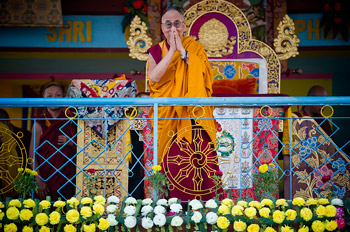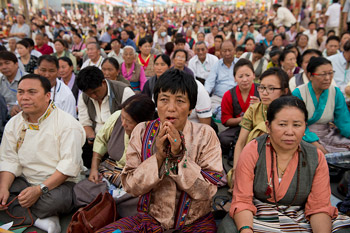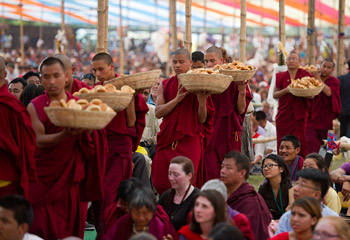Second Day of Teachings at Salugara
30/03/2013 19:54 (GMT+7) Font size:  
Salugara, West Bengal, India, 28 March 2013 - His Holiness arrived promptly at the Salugara Kalachakra Phodrang to resume his teaching this morning. These days, the building ordinarily hosts a Himalaya Buddhist Cultural Association school offering classes 1-8 in an English medium, with an emphasis on Bhotia and Hindi. Students come from across the Himalayan region and nearby. An estimated 25,000 people have gathered from Salugara, Darjeeling, Kalimpong, Sikkim and Bhutan to hear His Holiness. The weather was hot and sultry, but people were protected from the direct sun by a canopy that covered most of the ground.
His Holiness’s first advice concerned the prayers and recitations to begin the session: 
| His Holiness the Dalai Lama acknowledging the crowd gathered to here his teachings in Salugara, West Bengal, on March 28, 2013. Photo/Tenzin Choejor/OHHDL
|
“We’ll say the prayer that combines taking refuge with generating the awakening mind. If we were to give a detailed explanation of this short verse, we could use it to summarise the entire Kangyur, the entire teachings of the Buddha. The first two lines indicate that we are taking refuge in the Buddha, Dharma and Sangha. The refuge of the bodhisattvayana implies taking refuge until we have eliminated all the mind’s defilements, along with their imprints, and achieved the Dharmakaya. In other words, until enlightenment.”
He explained that there is the causal refuge, taking refuge in the Buddha, Dharma and Sangha prior to our own enlightenment, and the resultant refuge, the Buddha, Dharma and Sangha that we achieve when we reach enlightenment. To begin with, in this fortunate era, there was the Buddha Shakyamuni. He was born into a royal family, renounced that way of life, practised austerities for six years, became a Buddha under the Bodhi tree and then turned the wheel of Dharma for the first time when he taught the first five human disciples in Sarnath. In the second turning of the wheel, he presented the perfection of wisdom teachings, while as a result of the third turning of the wheel, disciples began to develop the Dharma within themselves.
It is because we have Buddha nature that defilements can be removed from the mindstream. It is our Buddha nature, the empty nature of the mind, which transforms into the Dharmakaya. When we become a Buddha the body, speech and mind are said to become of one taste. Once the innate luminous nature of the mind is completely free of the defilements that obscure it, we attain enlightenment. At that point we display enlightened qualities and engage in enlightened activities.
“The next two lines say through the merit of my generosity may I lead all sentient beings to enlightenment. Sometimes we may think that we can collect merit alone and disregard wisdom, whereas we need to accumulate both stores of merit and wisdom. When the Buddha taught the Four Noble Truths, he was referring to the causes due to which we spin in cyclic existence, but also to the causes due to which we gain liberation from cyclic existence. This, as I shall explain later, is illustrated by the twelve links of dependent arising.”

| Some of the over 25,000 people that are attending His Holiness the Dalai Lama's teaching in Salugara, West Bengal, on March 28, 2013. Photo/Tenzin Choejor/OHHDL
|
This prayer refers to ‘I’ as the agent. We tend to view the ‘I’ as like the ruler of our body and mind, and yet there is no place in the Buddhist view for such a thing. There is no such autonomous ruler of our body and mind. Even a Buddha is only designated in terms of the enlightened body, speech and mind. We too are only designated on the basis of the five psycho-physical aggregates.
His Holiness added:
“When we say, ‘May I become a Buddha in order to benefit all sentient beings,’ we are generating or renewing the awakening mind of bodhichitta. And the context is ‘Through the merit of my practice of generosity and so forth, may I become a Buddha.’ Reflect on the meaning of these lines.”
“When there’s a Dharma teaching like this,” he said, “both the teacher and the listeners should have a proper motivation, otherwise the teaching can be ineffective. The student should be unbiased, for as Aryadeva says, if you are biased you’ll never find peace. If you are not impartial, you won’t be able to see reality clearly.”
His Holiness remarked that he usually tells people that there are two aspects to the Buddha’s teachings: the philosophical view of dependent arising and the conduct of non-violence. Both accord with the law of causality that is accepted by all schools of Buddhism. The importance of the emphasis on not doing harm to others is that in addition to helping them it brings peace. In the Madhyamika view, things are empty of independent existence because they are dependent on other factors.
His Holiness also divides Buddhist literature into Buddhist science and philosophy on the one hand, and Buddhist religion on the other. The science and philosophy can be studied in an academic way. There is a great deal to be learned from the Buddhist science of mind. The function and transformation of the emotions need not have a religious context, but may be studied for the direct benefits that ensue.

| | Monks distributing bread to the audience during His Holiness the Dalai Lama's teaching in Salugara, West Bengal, on March 28, 2013. Photo/Tenzin Choejor/OHHDL |
His Holiness encourages people to study, whether or not it is in an academic framework. He mentioned that in Ladakh people have established Buddhist study groups to learn about and discuss the teachings. He stressed that to understand Buddhist teachings you have to use intelligence.
At the end of his general explanation and introduction he opened Longchen Rabjam’s ‘Resting the Mind in its Natural State.’ In a classic manner it explains the value of a fully qualified human life, how hard it is to find, and how important it is to use it meaningfully. It goes on to consider the certainty of death, the uncertainty of when it will occur and the conviction that the only help at the time is your practice of the Dharma. The intention is to stress the need to put the Dharma into practice without delay. In this connection, the Buddha stated that we are the masters of our own destiny. However, as His Holiness jokingly pointed out, many Buddhists seem to pray as if happiness is something bestowed by an external god, whereas the Buddha made it clear that we each have to take our own action to find happiness.
Continuing this theme after lunch, he observed that suffering is due to karma and delusion and just as everything comes to stop when the electricity is turned off, so we can put an end to suffering if we stop the flow of karma and delusion. He alluded to the Wheel of Life that is often found painted on temple verandas. The outer circle depicts the twelve links of dependent origination, while in the centre a pig, a rooster and a snake are chasing each other in a circle. They represent the destructive emotions of attachment and anger that are rooted in ignorance. Ignorance, represented as a blind person is the first of the twelve links, gives rise to karma, depicted by a potter, which leaves imprints on consciousness depicted by a monkey, and so on up to aging and death. Nevertheless, by cultivating skilful means and wisdom we can achieve liberation.
Chapter 5 of Longchenpa’s text deals with relating to the spiritual master, who is likened to a physician, his teaching to medicine to cure the disease of disturbing emotions. At the end of Chapter 8 that discusses the awakening mind of bodhichitta, His Holiness turned to Je Tsongkhapa’s ‘Concise Stages of the Path to Enlightenment’, which concurs that the awakening mind of bodhichitta is the central pillar of the Great Vehicle path. Turning back again to Longchenpa’s text, His Holiness made an energetic effort to read most of the text before the end of the afternoon.
His Holiness promised to give lay-practitioner’s vows and bodhisattva vows in connection with an Avalokiteshvara empowerment tomorrow morning, all of which involve establishing trust and commitment to the lama. In the light of this, His Holiness clarified that there may still be some people who choose to persist in their worship of the pernicious spirit Shugden or Dolgyal, about which his advice has been clear for a long time. If that is the case, he asked them not to come tomorrow. On the other hand, if they choose to give it up, and they should feel no fear or sense that they are putting themselves at risk by doing so, they will be welcome to attend.  http://www.dalailama.com.
|